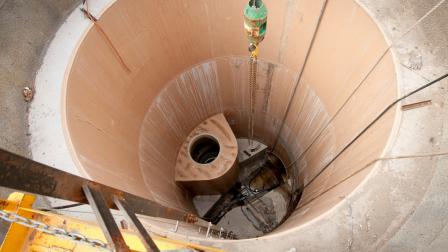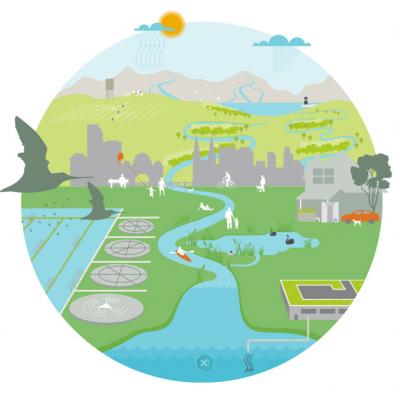Learn how water moves naturally between the land, ocean and atmosphere, how it ends up in your home – and where it goes from there.
Natural water cycle
Water is always cycling around, through and above the Earth in a natural water cycle that has existed for billions of years. As water moves between the land, ocean, rivers and atmosphere it changes from solid to liquid to gas. This natural water cycle is our planet’s way of recycling water, and is essential for life on Earth.
Stages of the natural water cycle
The stages of the cycle are:
- evaporation — water molecules get energy from the sun, which breaks the bonds between them and lets them escape into the atmosphere as vapour gas, leaving salt, minerals or metals behind
- condensation — vapour cools as it rises, changing back into tiny water droplets that join to form clouds
- precipitation — water falls to earth when too much has condensed for the air to hold, becoming liquid (rain) or solid (snow, sleet or hail) depending on the air temperature
- infiltration — some water soaks into the ground (groundwater) and slowly seeps into rivers, or is absorbed by plant roots
- run-off — some water flows across land (surface water) and collects in creeks that flow into larger rivers
- transpiration — water returns to the air as it evaporates from plants, mainly through their leaves.
Urban water cycle
People have changed the natural water cycle; building pipes take water for drinking and remove sewage and stormwater. This is the urban water cycle, and in Melbourne is managed by Melbourne Water.
Play the Drip Trip game to learn more about the interactive water cycle.
Water: from catchments to tap
Most of Melbourne’s drinking water comes from mountain ash forests high in the Yarra Ranges, which have been closed to the public for over 100 years to keep our water clean.
When it rains, the run-off flows into rivers and onto the reservoirs and water mains that make up our water supply system – eventually making its way to you!
Sewage: from toilet to sewage treatment plant
Used water from homes and businesses travels through sewer pipes to two major sewage treatment plants in Melbourne’s east and west – all part of our sewerage system.
These plants remove toxic substances so the sewage can be safely pumped out to sea and back into the natural water cycle, or recycled on farms, parks and golf courses.
Stormwater: from drains to our bays
Stormwater drains collect rainwater run-off from roads, roofs and gutters, and send it into nearby rivers and creeks. These eventually carry the water into our bays, where it re-enters the water cycle.
You may also like...
Our water supply system
Melbourne has some of the highest-quality drinking water in the world. Learn how it makes its long journey to your tap.

The importance of sewerage
Get the lowdown on Melbourne’s sewerage system, how we look after it and what you can do to help.


